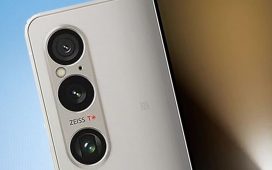Sony TVs are known for their premium design, excellent picture processing capabilities, and advanced software, which often caters to A/V enthusiasts. The A80K and the X95K are among the best Sony TVs available today. They offer fantastic performance and a heaping helping of features for gamers and streamers alike.
This is where things get confusing. While one is an OLED and the other uses a mini-LED backlight, the A80K and X95K are remarkably similar in price and share nearly all of the same features, so how do you go about picking the right one? Fortunately, we’ve done all the work for you, having spent hours testing both. Here’s what you need to know.
Price

Credit:
Reviewed / Timothy Renzi / Best Buy
Unless you’re looking for a really big screen, the Sony A80K is a good choice.
Sony A80K:
The Sony A80K is available in just three sizes, the smallest of which is a 55-inch model. Right now, the 55-inch model can be had for around $1,300, while the 65-inch version will run you about $1,700.
Sony X95K:
The Sony X95K is also only available in three sizes, and all of them are big. Big-screen enthusiasts will appreciate the 75- and 85-inch options, but anyone shopping for a 55-inch TV is out of luck with this series.
Right now, the 65-inch X95K is about $100 more than the 65-inch A80K, but the 75-inch X95K is about $200 less than an A80K of the same size.
If you’re shopping for a 55-inch TV, the A80K is your only choice. If you’re shopping for an 85-inch TV, the X95K is your only choice. At 65 inches, the A80K holds the cheaper option, but at 75 inches, the X95K is more affordable. This category is too close to call.
Our pick: Draw
Design

Credit:
Reviewed / Betsey Goldwasser
Both the Sony X95K (pictured) and A80K have three stand positions for flexible table placement.
In recent years, the design of most Sony TVs has maintained a balance between function and fashion. They’re sleek, sturdy, and oftentimes more accommodating than the average TV. This is the case for both the A80K and the X95K, which offer multiple stand configurations if you don’t intend on wall-mounting your next TV.
Both models rely on a pair of slim, blade-like feet that can be positioned in three ways. One option places them at (or near) the corners of the panel while keeping the TV low to its surface. If you have a narrow table or media console, you’re probably better off using the A80K or X95K’s alternative stand slots, which sit closer to the center of each TV’s panel.
The A80K and the X95K offer a third configuration, too—one that’s ideal for those who use a soundbar. This setup elevates each TV’s panel about 2.5 inches.
Thanks to their premium display hardware, each of these models is more svelte than the average TV, though not as sleek as some of the competitors in their class. The A80K isn’t as thin as other OLED TVs (like the LG C2 and Samsung S95B, for instance), but it’s impressively compact, nonetheless. The X95K’s panel is roughly twice as thick as our favorite mini-LED TV, the Samsung QN90B, but it still packs a ton of hardware into a slim package.
Regardless of whichever you choose, these TVs play the part of a premium home theater centerpiece well. They’re not only handsomely designed but accommodating as well.
Our pick: Draw
Features and smart platform

Credit:
Reviewed / Betsey Goldwasser
A closer look at the connectivity ports and of the Sony X80K remote.
Despite some major differences in display hardware, these high-end Sony TVs offer many of the same features. Let’s break down everything the A80K and the X95K have in common.
A/V enthusiasts and film fans will feel right at home with either TV. Both support Dolby Vision, one of the most popular HDR formats available. Additionally, both the A80K and the X95K can decode Dolby Atmos audio natively or pass it via eARC to Dolby Atmos soundbars—either in the uncompressed format (Dolby TrueHD) or the compressed format (Dolby Digital Plus).
On the gaming side of things, the similarities run deep, as well. Both TVs support Variable Refresh Rate (VRR) and Auto Low Latency Mode (ALLM) right out of the box. These features ensure a smooth gameplay experience every time a console is in use. The A80K and X95K also support HDMI 2.1 4K gaming at 120Hz, though only two out of their four inputs support it, and one of them also doubles as the TV’s dedicated eARC port. If you own an Xbox Series X, a PlayStation 5 and an eARC-enabled device, you’ll either need to invest in an A/V receiver or relegate one of your consoles to a port that tops out at 4K/60Hz.
Both the A80K and the X95K arrive with Google TV preinstalled. Despite a heavy dose of sponsored content across the platform (particularly on the home screen), the software is quick, the user interface is easy to learn, and there are plenty of downloadable apps available if the preinstalled batch doesn’t suffice. Dedicated streamers will feel right at home, regardless of which Sony TV they choose—the software experience is identical.
In fact, in all major features categories, the A80K and the X95K are virtually indistinguishable. Both deliver an impressive set of features and pair them with a top-notch smart platform that’s perfectly suited to be your daily driver.
Our pick: Draw
Performance

The Sony X95K menus and Google TV OS are smooth with a peppy response.
The A80K and X95K are high-performing TVs with entirely different visual expressions. Although both have the benefit of Sony’s superb picture processing capabilities, their strengths and weaknesses can be chalked up to their respective display technologies. How you watch TV (and the room you watch it in) will ultimately determine which is right for you.
Like all OLED panel TVs, the A80K’s foundational asset is its contrast. The display technology allows for perfect black levels, which create a sense of depth and clarity that non-OLED TVs can’t quite compete with. There is no light bloom whatsoever, so illumination from brighter picture elements doesn’t spill into the surrounding region. Another benefit of OLED TVs are their ultra-wide viewing angles; their color and contrast hold up during off-axis viewing better than any LED TV on the market.
The X95K, on the other hand, features a mini-LED display enhanced by quantum dots. This is one of the best combinations of display technologies available for the LED TV class. The tandem typically offers a bright, colorful picture, and the small stature of mini-LEDs allows for tight contrast control.
But as good as mini-LED TVs can be at maintaining steady, deep black levels, the contrast of an LED TV doesn’t hold a candle to the contrast ratio of an OLED TV. The X95K does a decent job of limiting light bloom whenever bright objects clash with darkness (like title cards and subtitles), but the phenomenon is always looming, particularly during dark content. In addition, the X95K tends to lift its black levels whenever an average amount of bright and dark elements are on screen. Shadows, for instance, appear a lighter shade of gray than they ought to, giving the picture a somewhat milky appearance.
Some of these issues—especially the light bloom—are exacerbated during off-axis viewing. If you sit just 30° off to the side, you’re bound to have a less-than-ideal viewing experience. Since the X95K is only available in large sizes, this is important to keep in mind.
But there’s one area of performance where the X95K crushes its OLED-equipped alternative: peak brightness. OLED displays have steadily grown brighter after years of technological advancement, but they’re not the best choice for sun-soaked living rooms. The A80K’s average picture brightness is around 200 to 300 nits, with HDR highlights climbing as high as 650 to 700 nits. The X95K’s average picture brightness settles into the 550- to 700-nit range, with specular highlights often eclipsing 1,000 nits. HDR content is going to pop on both TVs, but there’s far more of an “oomph” on the X95K—so long as you can make do with its lifted black levels and light bloom.
Both TVs deliver a high-class picture with vibrant, accurate color, but how they get there is entirely different. The A80K is technically the better performer, but if your living space is bright and you do a fair amount of viewing during the day, the X95K might be the preferred choice.
Our pick: Sony A80K
And the winner is…

Credit:
Reviewed / Timothy Renzi
The A80K has excellent color accuracy out of the box and covers 99% of the DCI-P3 HDR color space.
The Sony A80K wins, but only by a hair.
Shoppers on the hunt for a 55-inch TV won’t find one in the Sony X95K series, while those in the market for a larger-than-life, 85-inch TV are locked out of the A80K series. When it comes to price, design, and features, these TVs are neck and neck, too.
If you’re shopping for one of the two sizes shared by these two series (65 and 75 inches), ask yourself this question: Do you want a premium TV with a gobsmackingly good picture that oftentimes appears too dim in a bright room during the day, or do you want one with a handful of flaws, but still capable of holding up in brighter settings?
If you’re a picture purist who values dark room viewing above all else, go with the A80K. If you’d feel more comfortable with the sheer horsepower of a bright, punchy display (or if your living space is especially sunny), I recommend the X95K.

Sony A80K
The A80K is a terrific option for OLED bargain hunters who appreciate the look and feel of a Sony-branded TV.
The product experts at Reviewed have all your shopping needs covered. Follow Reviewed on Facebook, Twitter, Instagram, TikTok, or Flipboard for the latest deals, product reviews, and more.
Prices were accurate at the time this article was published but may change over time.










